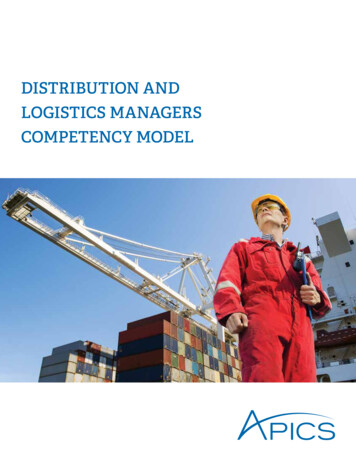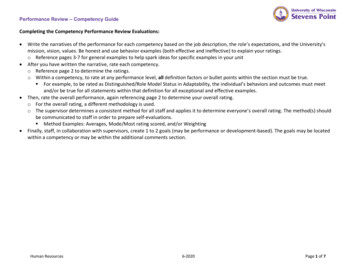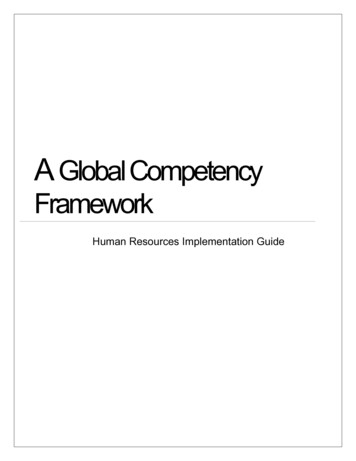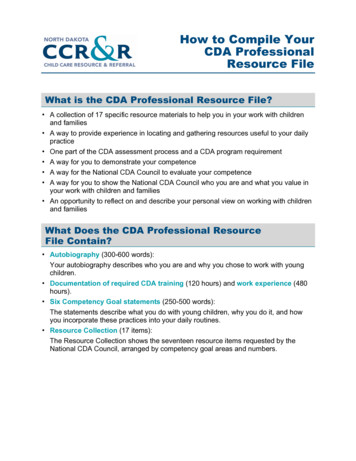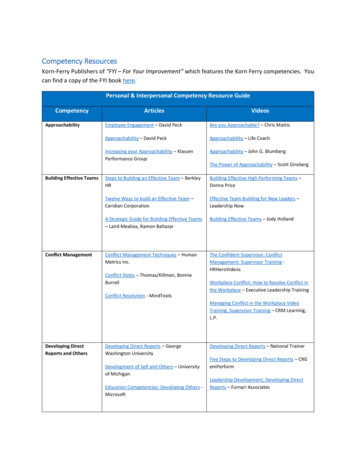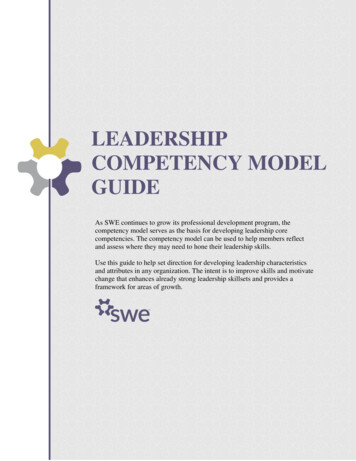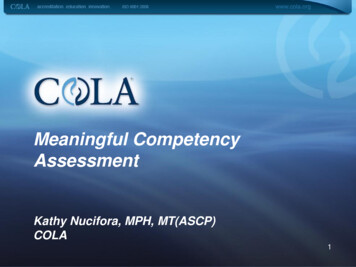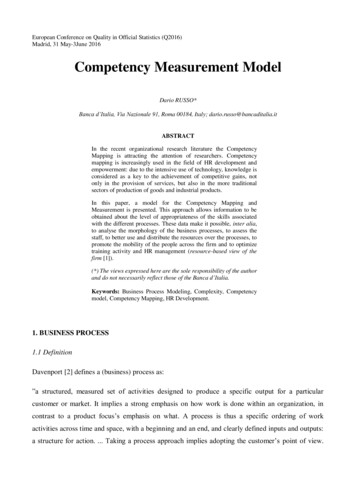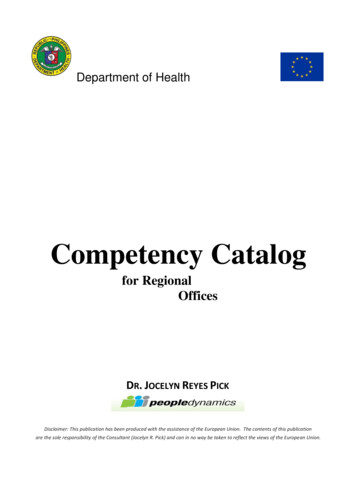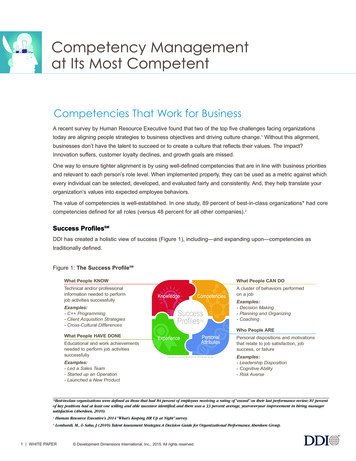
Transcription
Competency Managementat Its Most CompetentCompetencies That Work for BusinessA recent survey by Human Resource Executive found that two of the top five challenges facing organizationstoday are aligning people strategies to business objectives and driving culture change.1 Without this alignment,businesses don’t have the talent to succeed or to create a culture that reflects their values. The impact?Innovation suffers, customer loyalty declines, and growth goals are missed.One way to ensure tighter alignment is by using well-defined competencies that are in line with business prioritiesand relevant to each person’s role level. When implemented properly, they can be used as a metric against whichevery individual can be selected, developed, and evaluated fairly and consistently. And, they help translate yourorganization’s values into expected employee behaviors.The value of competencies is well-established. In one study, 89 percent of best-in-class organizations* had corecompetencies defined for all roles (versus 48 percent for all other companies).2Success ProfilesSMDDI has created a holistic view of success (Figure 1), including—and expanding upon—competencies astraditionally defined.Figure 1: The Success ProfileSMWhat People KNOWWhat People CAN DOTechnical and/or professionalinformation needed to performjob activities successfullyA cluster of behaviors performedon a jobExamples:- C Programming- Client Acquisition Strategies- Cross-Cultural DifferencesExamples:- Decision Making- Planning and Organizing- CoachingWho People AREWhat People HAVE DONEEducational and work achievementsneeded to perform job activitiessuccessfullyExamples:- Led a Sales Team- Started up an Operation- Launched a New ProductPersonal dispositions and motivationsthat relate to job satisfaction, jobsuccess, or failureExamples:- Leadership Disposition- Cognitive Ability- Risk Averse*Best-in-class organizations were defined as those that had 84 percent of employees receiving a rating of “exceed” on their last performance review; 81 percentof key positions had at least one willing and able successor identified; and there was a 33 percent average, year-over-year improvement in hiring managersatisfaction (Aberdeen, 2010).1Human Resource Executive’s 2014 “What’s Keeping HR Up at Night” survey.2Lombardi, M., & Saba, J. (2010). Talent Assessment Strategies: A Decision Guide for Organizational Performance. Aberdeen Group.1 WHITE PAPER Development Dimensions International, Inc., 2015. All rights reserved.
The Success ProfileSM separates four important and distinct components of success, resulting in a powerfulframework for selection decisions. This separation allows HR to give personal dispositions and motivations—that are difficult to develop—extra attention when considering candidates for a role. The competency componentdefines the specific behaviors and capabilities that need to be demonstrated proficiently to achieve success.And, with the clear identification of specific experiences and knowledge vital for success in a growth assignment,development can be individually targeted. Each component of the Success Profile describes unique requirementsthat can be fine-tuned to meet the needs of your various talent management systems. This is done by targetingonly the most critical elements of the profile, which clearly differentiate exceptional performance from mediocreperformance or worse.The Value of Success Profiles Varies by StakeholderThe design and launch processes should add value for four key stakeholder groups: senior leaders, managers,employees, and the talent management team. It is critical that you consider each group and define what theywill gain from using the competency model.Senior LeadersManagersEmployeesTalent Management TeamSuccess Profiles becomethe primary source of intelligence upon which crucialtalent decisions can bemade: the WHOs to putin available positions, orthe WHATs required byyour strategic development.They also ensure alignmentof HR’s strategies withthose of the business. And,when the strategy needs tochange, Success Profilescan be quickly revisited toclarify what should remainconstant and what shouldchange to meet newdemands.Success Profiles focusmanagers on the criticallyimportant targets whenacquiring talent, developingand evaluating employees incurrent roles, and gettingemployees ready for futurecareers. This increasesmanagers’ confidence thatthe decisions they makeare fair and aligned withboth their team’s and theorganization’s goals. Forcompetencies to provide thisvalue, they must be definedat the appropriate job level.In addition, managersshould be trained to usethe competencies and otherelements of the SuccessProfile across all talentmanagement systems.Success Profiles connectemployees at all levels tothe organization’s strategyby identifying how theycan achieve expectedresults at their job andlevel. Competenciesprovide clear expectationsfor how goals should beaccomplished, and theyhelp employees understandthe skills they need todevelop in their currentand future-planned roles.Employees should also beoriented to the meaning ofthe competencies andtrained in applying them.Success Profiles serveas the foundation uponwhich HR should buildand connect talent management systems. Thisunified approach reducesboth implementation costsand confusion. For example,a Success Profile for a firstlevel leader can be usedfor recruiting, onboarding,appraising performance,and development. Duringthe competency modelingdesign process, HR shouldencourage stakeholderconversations about business challenges and then,and only then, choose connected Success Profiles.The links to business challenges ensure buy-in byline managers and buildthe reputation of the talentmanagement team aseffective business partners.2 WHITE PAPER Development Dimensions International, Inc., 2015. All rights reserved.
Failing to Realize the Competency PromiseEven with the evidence pointing to the value of competencies, many organizations still fail to reap the fullbenefits. Organizations typically face a variety of challenges when implementing competencies, including:Design Issues No strategic starting point; competency development is fragmented and haphazard. Little thought is given to how competencies are going to be used across talent management systems,or if used, they are applied inconsistently.Launch Issues Descriptions of competencies are too broad. They are not a road map for taking action viaspecific behaviors. Users are not provided with the skills to use the competencies effectively. The competencies are hard to embed consistently into all talent management systems.Sustainability Issues There is no ongoing ownership or accountability to support competency applications in systems. No process is in place to evaluate what is working and not working or to make appropriate changes. There is a lack of agility for a quick response to changing business needs and no way to assess thevalue (ROI).As evidenced by these common challenges, even the best competencies are going to fall short if they aren’texecuted properly. That’s not to say defining competencies isn’t important; you must give equal consideration toboth launching and deploying them.The Higher Power of Integrated Talent ManagementIntegrated talent management is the process by which individual HR processes are aligned to common businessobjectives, as well as to each other. DDI pioneered the entire concept of integrated talent management morethan 30 years ago, long before it was an acknowledged best practice.3 Integrated talent management systemsenhance the impact of all talent management systems. Bersin and Associates4 cites the following organizationalbenefits for integrated talent management: 26 percent higher revenue per employee 40 percent lower turnover among high performers 87 percent greater ability to “hire the best people” 156 percent greater ability to “develop great leaders”3Byham, W.C. (1981). Applying a systems approach to personnel activities, DDI.4Sherman Garr, S., (2012) Integrated Talent Management: A Roadmap for Success. Bersin and Associates.3 WHITE PAPER Development Dimensions International, Inc., 2015. All rights reserved.
As shown in Figure 2, DDI views Success Profiles at thecenter of what we call the Talent Growth Engine. The key is aligningFigure 2: Fueling Your TalentGrowth Enginethe systems used to select and develop the talent around yourSuccess Profiles, which in turn should be aimed at achieving yourbusiness outcomes and cultural strategy.Putting Competencies to WorkCompetencies have become widely popular, in part, because theyprovide value in diverse work contexts, cultures, industries, andacross multiple talent management applications. Some commonapplications of competencies are:1. Talent Acquisition: DDI research shows that companies thatuse competencies are more likely to rate their staffing processesas effective, when it comes to filling key positions quickly andeffectively. Also, when organizations thoroughly define holisticSuccess Profiles, they are better able to compete to source andhire the talent required (Figure 3). Finally, when business-criticalFigure 3: Talent Acquisitioncompetencies are targeted in interviews and assessments, thetalent entering the organization is better prepared to meet business needs, reducing ramp-up time.2. Learning and Development: Competencies provide the framework onwhich individuals can build development plans and managers canprovide feedback. At an organizational level, development can bemore effectively planned and implemented when specific behaviorsand skills are clearly identified and communicated. DDI’s researchshows that organizations that identify Success Profiles are 4.8 timesmore likely to rate themselves in the top 10 percent of their competitors based on the quality of their leadership talent.3. Succession Management: Competencies offer clarity to seniorleaders as they build talent pools to meet business needs. Theyprovide standards against which individuals—across the organization—can be assessed. With the intelligence that comes fromassessment, organizations can pinpoint talent gaps before deficitsrear their ugly heads and negatively impact business results. Theycan also better use Success Profiles to place those individualswho are best qualified for key promotions or other opportunities.4. Performance Management: By leveraging competencies, managers and employees gain a common language thatspells out the HOWs in performance plans. Without competencies, there is a tendency for performance plans torely too heavily on the WHATs (outcomes/objectives), without providing behavioral guidance. Competencies helpdevelop performance plans so your associates understand the specific behaviors they need to exhibit in achievingresults. The competency framework is useful in evaluating associates, and providing feedback throughout theperformance cycle.4 WHITE PAPER Development Dimensions International, Inc., 2015. All rights reserved.
5. Career Planning: By identifying and communicating the criti-Order Matterscal competencies associated with success at a job level,Most organizations develop their Successorganizations can establish more strategic career-planningProfiles first, and then try to line them upsystems. Managers can help their employees identifywith their business strategies; the reversecareer paths for future-focused development that will bettershould happen. We suggest starting withprepare them for their next move.the identification of business imperatives6. Culture: Competencies help make an organization’s valuesand then using those imperatives totangible. For example, an organization may desire to builddecide on appropriate Success Profiles.a culture of innovation. However, innovation as a value isFor example, in Figure 4, you cansomewhat nebulous unless you can identify the behaviorssee how the competency and personalor skills essential to innovation. Managers need to reinforceattribute components of the Successthe behaviors in line with the desired culture and hire indi-Profile align to a specific business priority.viduals into the organization that possess skills and motivations that fit the culture.Figure 4:Aligning Success Profile componentsAchieving the Competency PromiseYour organization must take the time to put in place anoverarching strategic plan for all phases of the design andimplementation effort as depicted in the grey-shaded, outercircle of Figure 5. The four critical steps associated witheffective competency management are: Plan for Impact,Design, Launch and Engage, and Optimize.Step One: Strategic PlanningFigure 5: Steps for Effective Competency Management12341. Starting with a plan which sets a foundation for success.2. Building Success Profiles that align with business challenges.3. Engaging leaders and employees to use the profiles.4. Assessing their impact and adjusting as needed.5 WHITE PAPER Development Dimensions International, Inc., 2015. All rights reserved.to strategy, via Business Drivers
1Strategic Planning Identify stakeholders’ needs and the requirements of various talent management systems. Determine launch strategies that engage employees. Identify metrics and measurement methods to ascertain what is working and what needs to be improved.A McKinsey study6 found that organizations that planned from the outset for long-term sustainability were nearly twice as likelyto be good competency implementers as those who didn’t. Why is this important? Because the good implementers were alsonearly five times more likely to be successful at accomplishing their change efforts.Once a solid foundation with a strategic plan has been set, follow the key activities below. These will ensure success as youwork through the steps associated with successful implementation.2Design Tie the competencies to your business strategy. Identify those competencies that are critical in all of your systems and those that are best used in specific systems(e.g., less-trainable behaviors such as adaptability in selection systems). Ensure competencies are relevant to each of your target levels (e.g., individual contributors, leaders, and executives).Well-designed competency models specify by job level the competencies and behaviors appropriate to each level, andnot just a single “one-size-fits-all” set of competencies. To be scalable, focus on the behaviors rather than the tasks. Competency frameworks should clearly define the commonkey behaviors within each competency critical to effectiveness, and avoid a lot of specificity about tasks that can vary byjob/role and change frequently over time. To ensure scalable talent management systems, identify job families—those clusters of jobs that may have differentresponsibilities and titles, yet require similar competencies. Focus on job transitions, areas where competency requirements change significantly (e.g., individual contributors toleaders and managers to executives). Ensure your competencies are relevant to associates from all applicable cultures, functions, and locations.3Launch and Engage Plan communications targeted to each stakeholdergroup, establishing the value of the competenciesfor each group.4Optimize Establish ongoing accountabilities to help design talentmanagement systems that support the model. Integrate the competencies into your talent management systems in ways that enhance their impact. Document and share successes, and identify methodsto evaluate the impact of competency applications onbusiness and talent outcomes. Establish an engaging way to orient your users to—and reinforce buy-in for—the competency model. Gain an understanding of any challenges in applying Train your employees and managers to use thecompetencies in your talent management systems. Determine when the business strategy and the competitivecompetencies, and take action to address any issues.situation require modifications to the competency modeland quickly adapt the model to new challenges. Establish ways to keep talent management systems in syncwith changes in the competency model over time.6Pustkowski, Scott, Tesvic. (2014).Why Implementation Matters. McKinsey & Company.6 WHITE PAPER Development Dimensions International, Inc., 2015. All rights reserved.
Unfortunately, many organizations neglect one or more of these phases. Some companies have a few meetingsto develop a list of competencies. Other companies do extensive analysis and design, but spend little timelaunching the competencies so that all employees understand and use them. In other organizations, no oneowns the competencies—no one helps with the deployment and use of new competencies, evaluates theirimpact on the business, or recognizes the need to adjust them as the business evolves.But when done properly, you will be able to answer key business strategy questions such as: Do we have the talent needed to win in the marketplace and sustain long-term growth? What leader competencies (at all levels) are critical, but in short supply? What competencies and other attributes are not well-assessed or developed by our current talentmanagement processes?The Bottom-Line Value: Competencies Support Talent AnalyticsWith clear definitions of success, you can measure your talent capabilities by comparing business performanceagainst competency evaluation data.First, access assessment data from your talent management and performance systems. This will provide information based on the same elements identified during the Design phase mentioned above. An analysis of thesedata will enable you to identify the competencies which differentiate would-be outstanding performers fromthose who are ineffective.Next, review your talent management program’s evaluation results, such as users' perceptions of accuracy,relevance, and utility of your programs. These may also include outcomes such as rates of promotion, engagement results, and retention. You should also seek sales customer satisfaction, productivity, and quality and safetymetrics. From these, you can effectively target improvements to all your talent management systems and minimize talent gaps that affect your business and culture.When an integrated Success Profile is deployed throughout your talent management systems, you’ll be able toperform talent analytics to answer the critical questions with a higher degree of speed and accuracy. Thisis the promise of optimized competency management.To learn more visit www.ddiworld.com/expertise/competency-management.7 WHITE PAPER Development Dimensions International, Inc., 2015. All rights reserved.
Just Too Many Competencies?Too often competency models use only generalized descriptors of meanings or provide a one-size-fits-alldefinition for a concept. For example, “coaching others”: If the competency is too vaguely defined, a managermay fail at fully developing all the behaviors associated with proper coaching. Well-written competenciesinclude key actions that specify the component behaviors that lead to strength and define the unique behaviorsthat lead to success, across key leadership levels throughout the organization. These behaviors provide abetter guide for evaluation and development.A better competency library would include well-defined behavioral anchors that differentiate HOW to coachothers for executives versus coaching for front-to-mid-level leaders. The coaching example below offers amore explicit example of coaching behaviors defined for multiple levels of leadership:Example: Coaching and Developing Others(for Executives)Example: Coaching(for Front to Mid-Level Leaders)Providing feedback, instruction, and developmentEngaging an individual in developing and committingguidance to help others excel in their current orto an action plan that targets specific behaviors,future job responsibilities; planning and supportingskills, or knowledge needed to ensure performancethe development of individual skills and abilities.improvement or prepare for success in newresponsibilities.Key Actions Clarifies performance Provides timely feedback Conveys performance expectations and implications Evaluates misalignment Facilitates development Fosters developmental relationshipsKey Actions: Aligns expectations for the discussion Defines the performance challenge Maintains motivation Engages and involves Offers support Gains agreement Establishes action plan CONTACT USDeloitte Consulting (Pty) Ltd: 27 (0) 833757840 www.deloitte.com/za8 WHITE PAPERMKTSEWP12-0115 Development Dimensions International, Inc., 2015. All rights reserved.
which HR should build and connect talent man-agement systems. This unified approach reduces both implementation costs and confusion. For example, a Success Profile for a first-level leader can be used for recruiting, onboarding, appraising performance, and development. During the competency modeling design
